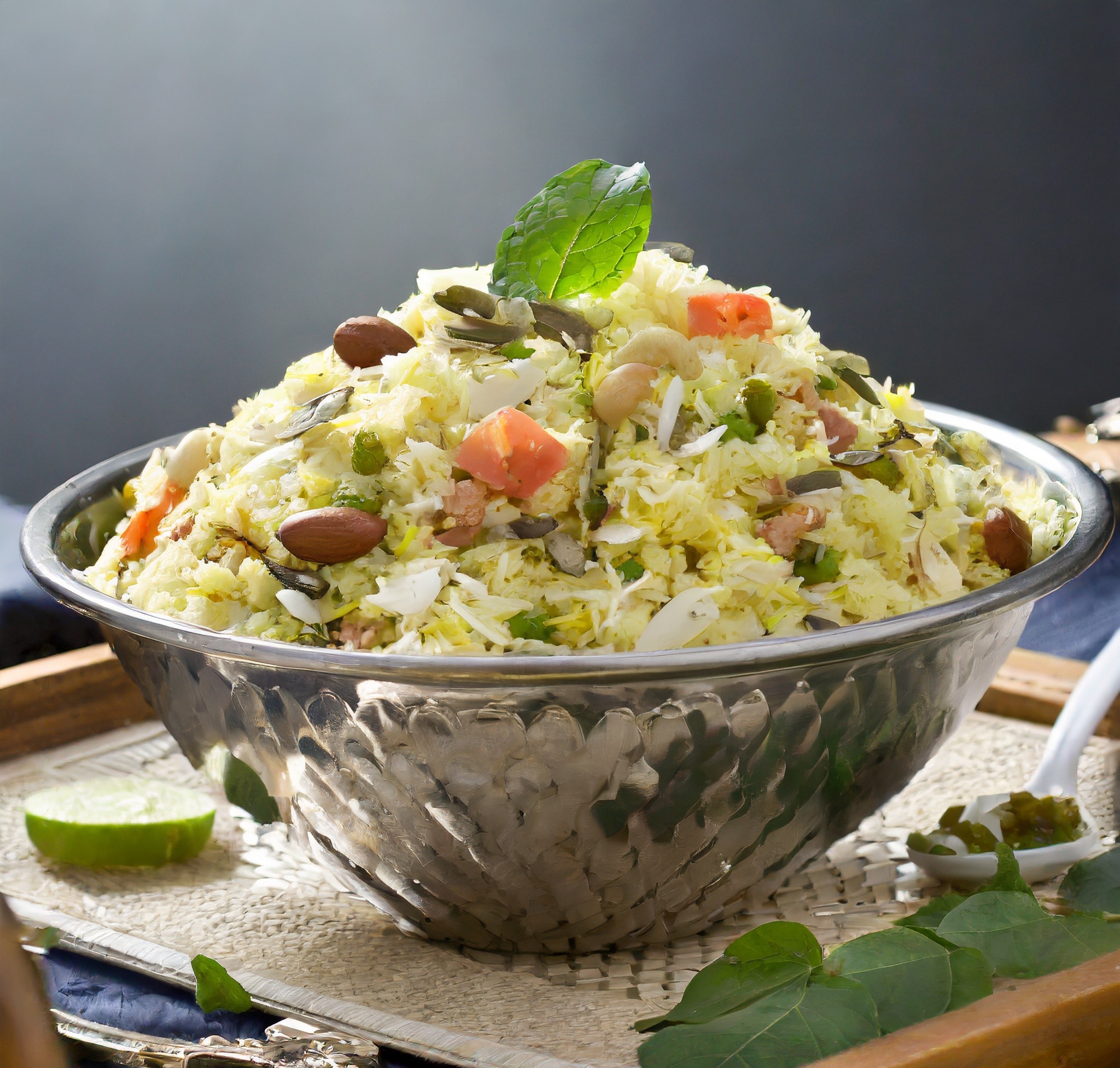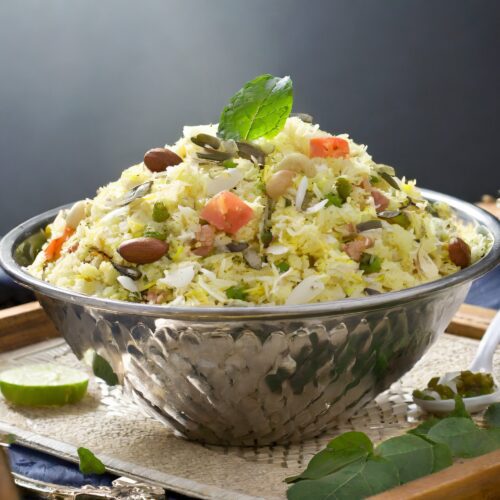How to Make Kanda Poha | A Traditional Maharashtrian Breakfast Dish

Introduction
Kanda Poha, a beloved breakfast dish hailing from the western Indian state of Maharashtra, is a flavorful and satisfying way to start your day. With its roots deeply embedded in Maharashtrian cuisine, Kanda Poha has gained popularity far and wide due to its delicious taste and ease of preparation. This humble dish features flattened rice (poha) cooked with onions, mustard seeds, curry leaves, and an array of aromatic spices. In this article, we will delve into the origins of Kanda Poha, explore its traditional preparation methods, discuss its health benefits, variations, and serving suggestions, as well as provide useful tips to elevate its flavors. So, get ready to immerse yourself in the world of Kanda Poha and discover how this iconic breakfast dish can add a touch of Maharashtrian charm to your mornings.
1. The Origin and Significance of Kanda Poha
Kanda Poha, the beloved breakfast dish from Maharashtra, has a rich history and cultural significance. “Kanda” stands for onions, and “Poha” refers to flattened rice. This dish originated in Maharashtra and has been enjoyed by generations of Maharashtrians. It is not just a popular breakfast option but also holds a special place in festivals and celebrations.
2. Cultural Importance and Popularity of Kanda Poha
Kanda Poha is more than just a dish; it represents the vibrant Maharashtrian culture. It is often associated with warmth, comfort, and togetherness. Whether it’s a lazy Sunday morning at home or a festive occasion, Kanda Poha brings people together. Its popularity has spread beyond Maharashtra, with food lovers across the country and even worldwide embracing this flavorful dish.

Kanda Poha
Ingredients
Kanda Poha Recipe
- 2 cups thick poha (flattened rice)
- 1 large onion, finely chopped
- 1/2 cup roasted peanuts
- 3 green chilies, finely chopped
- 1/2 tbsp mustard seeds
- 1/2 tbsp cumin seeds
- 1/2 tbsp turmeric powder
- A pinch of asafoetida (hing)
- 10-12 curry leaves
- 2-3 tbsp vegetable oil
- Salt to taste
- Freshly chopped coriander leaves for garnish
- Freshly grated coconut (optional, for garnish)
- Lemon wedges for serving
Instructions
- Start by rinsing the poha under running water. Place the poha in a sieve and gently wash it. Be careful not to over-soak it; you just want to moisten it slightly. Drain any excess water and set it aside.
- In a large pan, heat the vegetable oil over medium heat. Add the mustard seeds, cumin seeds, and asafoetida. Allow the seeds to splutter.
- Add the chopped onions and sauté them until they turn translucent.
- Now, add the green chilies, curry leaves, and roasted peanuts. Continue to sauté for a couple of minutes until the peanuts become crisp.
- Sprinkle turmeric powder and salt over the mixture. Mix well.
- Add the rinsed and drained poha to the pan. Gently toss the poha with the onion and spice mixture. Ensure that the poha is evenly coated with the spices and turns yellow due to the turmeric.
- Cover the pan with a lid and let it cook on low heat for 5-7 minutes. This will help the poha become soft and absorb the flavors.
- Check the seasoning and adjust salt and spice levels according to your taste.
- Once the poha is cooked, remove the pan from the heat and garnish with freshly chopped coriander leaves and grated coconut.
- Serve hot with lemon wedges for that perfect tangy kick.
Notes
Cultural Significance:
Kanda Poha holds a special place in Maharashtrian culture. It is a popular breakfast dish in the state, enjoyed by people of all ages. The name “Kanda” refers to onions, which are a key ingredient in this dish. The humble Kanda Poha is not just a meal; it’s a comfort food that connects people to their roots and brings them together. In many Maharashtrian households, Kanda Poha is a common offering during festivals and special occasions. It is also a popular street food, making it accessible to everyone, from college students looking for a quick and affordable snack to office-goers seeking a delicious breakfast option.Tips and Tricks to Enhance the Flavor and Texture of Kanda Poha
1. Experimenting with Different Garnishes and Toppings
While Kanda Poha is already packed with flavor, there’s always room for a little extra pizzazz. Experimenting with different garnishes and toppings can take your breakfast experience to the next level. Sprinkle some freshly chopped cilantro or coriander leaves on top to add a refreshing touch. For a bit of crunch, try adding roasted peanuts or cashews. And if you’re feeling adventurous, a squeeze of lime juice or a sprinkle of chaat masala can give your taste buds a delightful wake-up call.
2. Adjusting Spices and Seasonings to Personal Taste
We all have different preferences when it comes to spices and seasonings. So why not tailor your Kanda Poha to suit your taste buds? If you like it spicy, don’t be shy with the green chilies. For those who prefer a milder flavor, reduce the amount of chili powder. You can also experiment with adding other spices like cumin, turmeric, or garam masala to give your dish a unique twist. Remember, the key is to make it your own and enjoy every bite!
Conclusion:
In conclusion, Kanda Poha is not just a breakfast dish; it represents a beautiful blend of flavors, culture, and tradition. Whether you are familiar with Maharashtrian cuisine or new to it, incorporating Kanda Poha into your breakfast routine is a delightful way to experience the authentic flavors of Maharashtra. From its humble origins to its versatility, health benefits, and regional variations, Kanda Poha has rightfully earned its place as a beloved dish. So, why not give it a try? Prepare a delicious plate of Kanda Poha, savor the comforting aromas, and embrace a taste of Maharashtra every morning. Your taste buds will thank you, and you will embark on a culinary journey that connects you to the rich heritage of this delightful breakfast dish.
FAQ:
1. Can I use any type of flattened rice for making Kanda Poha?
Yes, you can use any variety of flattened rice for making Kanda Poha. However, it is recommended to use thick or medium-thick poha for the best results. Thin poha tends to become mushy when cooked, while thick poha retains its texture and absorbs the flavors well.
2. Is Kanda Poha suitable for vegetarians and vegans?
Yes, Kanda Poha is a vegetarian and vegan dish. It does not contain any animal products or by-products. However, some variations may include roasted peanuts, which can be omitted if desired by those following a strict vegan diet.
3. Can I make Kanda Poha in advance and reheat it?
While it is best to enjoy Kanda Poha fresh and hot, you can make it in advance and reheat it when needed. However, keep in mind that the texture of the poha may slightly change upon reheating, becoming softer. To maintain its texture, reheat the poha gently over low heat and add a splash of water if necessary to prevent dryness.
4. Are there any alternative ingredients for those with dietary restrictions?
Yes, Kanda Poha can be adapted to accommodate dietary restrictions or preferences. For gluten-free options, ensure that the poha you use is labeled gluten-free. Additionally, you can customize the dish by adding or omitting certain ingredients based on your dietary needs, such as reducing the amount of oil, adjusting spices, or incorporating vegetables of your choice.
